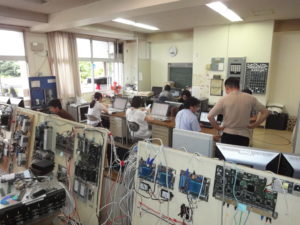RUNNING Culture in Japan
CONTENTS
The country has always had a strong tradition in distance running. Long before I moved here I noticed when watching the Olympics coverage, very disciplined Japanese runners were among the leading packs in the distance races. Years ago, I became fascinated with the uniquely Japanese ekiden (long‐distance relay road race) culture, more of which is mentioned below. On my many visits to Tokyo before moving there, I would join what seemed like hordes of very serious people as they ran laps of the famed 5km run around the Imperial Palace. However in the nearly 10 years I have actually lived here, the running revolution seems to have stepped up another level.
By D. McCaughan
Why Do Japanese People Love Running?
One serious runner told me that it really took off again after Naoko Takahashi won the Olympic Marathon gold medal at the 2000 Sydney Games. But many trace the current fad back to the launch of the Tokyo Marathon in 2007. I was fortunate to be a part of that event and being one of the 30,000 runners waiting in freezing, sleeting rain for the start. It was indeed a testament to the keenness of Japanese participants. Now over 300,000 officially apply for that race each year. Since the success of Tokyo Marathon, many other cities and communities around the country have upgraded or introduced local distance races in an attempt to get the interest of the booming running community and their penchant to spend on events, gear and revitalization of local economy. Not all marathons in the true sense as the term is used in Japan to describe any long distance race rather than just the strictly correct 42.195km event, but high quality, well managed and very heavily participated nevertheless.
According to the Japan Productivity Center’s White Paper of Leisure 2013, some 25.5 million Japanese say they are regular runners. That is more than any other sports and a massive 20% of the nation’s population. For many of them, running is relatively new. The same source found in a different survey that 16.5% of the population now participating in jogging or marathon training has only started as recently as the last five years. Much of that is driven by men (though women runners seem to be everywhere as well):
28.8% of 20 something aged men say they took up jogging or marathon training in the last five years,
24.2% of 30 something; 19.4% of 40 something; and 17.5% of 50 something.
Why Do Many Japanese Love Running?

As I said the country has a strong and unique running history. Take the ekiden for example. Long distance relay road races are not unique to Japan, but they are certainly a bigger part of the national sports scene than are similar events elsewhere. The ekiden involves teams of racers covering sometimes hundreds of kilometers in sections of different lengths. The most famous is the Hakone Ekiden that involves teams of 10 which represent each contestant university in the country. In the two day event at the beginning of the New Year, each runner does a length of around half a marathon in the total 217.9 kilometer race from Tokyo to Hakone and back passing a sash between runners at each stage. With its national television coverage and high level of competition and drama, it is a highly popular national event.
Even in our own offices, the number of people entering marathons, regularly jogging and talking about running seems to have steadily climbed. Curious about what drives all these runners, we asked over 50 of our staff why they run. It turned out that most were running a very respectable 20 kilometers or more a week, usually spread over three days. Not surprisingly most told us that they ran for some combination of physical health, stress relief and mental wellness, which are all easily understandable.
Perhaps it is just a part of an aging population syndrome. In previous articles, I have described some of the findings from our “Truth about Wellness Research” where we discovered that compared to people elsewhere, Japanese are more concerned about physical wellbeing rather than the emotional or spiritual. And that was at least in good part due to the concerns of future health in a country increasingly worried about who will take care of them in the future hence the need to stay as fit as possible. We have seen the trends that focused on health like “metabo” and the focus on losing weight, and more recently “locomo” which is all about maintaining or increasing the ability to move freely.
When I asked our staff, running friends and a couple of experts from some of the biggest running shoe brands as to why Japanese love running so much, I often heard versions: “because if you are a stoic person, you can do it yourself.” It sounds so Japanese. The belief in self-discipline is highly regarded. Of course I am sure some are inspired by writers like global bestselling novelist Haruki Murakami and his own account of his experiences as an ultra-distance runner, “what I talk about when I talk about running” and the way he expresses running as a way to really find yourself.
Runners Attract Sports Brand Makers’ Attention
It is indeed an individual sport, but I also heard that a great deal of its appeal was that it is not only enjoyed individually anymore. Top level runners can compete against themselves to improve their time, but have also various mediums/clubs/social network outlets to share the experience with their peers. Runners of all levels talked of the camaraderie. Even those who seemingly run alone around the Imperial Palace, as I do, get to “know” others who run at similar times and in some way share the experience while also measuring themselves against each other. Of course all the latest technologies allow runners to “measure themselves” more effectively. Japanese people love technology and whether it’s their “adidase miCoach” or “Nike Plus” these tools have proven huge hits in both creating motivation and comparison.
Read the related article: Marathons for Business in Japan; A Costumed Marathon in Japan


